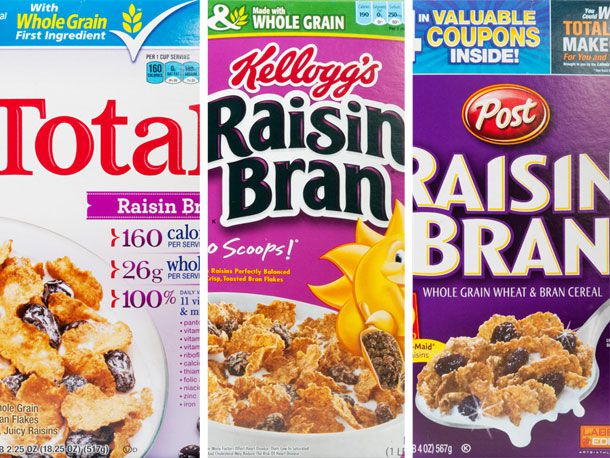If you’ve ever stood in the cereal aisle long enough, you may have noticed that there are three different products called “Raisin Bran” — Kellogg’s Two Scoops Raisin Bran, General Mills’ Total Raisin Bran, and Post’s Raisin Bran. How is it that three competing companies can use the exact same product name? Isn’t that what trademarks are supposed to prevent? The Raisin Bran story is a perfect case study in what can’t be trademarked: generic terms.
What Happened with Raisin Bran?
Originally, Raisin Bran was a trademark.
Skinner’s Manufacturing Company first coined the term in the 1920s to sell a cereal made of raisins and bran flakes. But by the 1940s, competitors like Kellogg’s and Post wanted to use the same phrase to describe their own similar cereals.
Skinner’s tried to stop them by suing under trademark law—and lost.
In Skinner v. Kellogg Co., the Eighth Circuit Court of Appeals ruled that “Raisin Bran” was merely a descriptive name for the cereal’s ingredients, and therefore not eligible for trademark protection.143 F.2d 895, 899 (8th Cir. 1944). It had become a generic term, like “apple pie” or “corn flakes.” The term wasn’t tied to a single source anymore—it simply told you what was in the box.
What Is a Generic Term in Trademark Law?
To assess the strength of a potential trademark, courts recognize four basic categories of marks: (1) Generic; (2) Descriptive; (3) Suggestive; and (4) Arbitrary/Fanciful. Two Pesos, Inc. v. Taco Cabana, Inc., 505 U.S. 763, 768 (1992).
A generic term is the common name for a type of product or service. Think of “milk,” “computer,” or “email.” These words can’t be trademarked because they don’t distinguish your brand—they just tell the customer what you’re selling.
Trademark law is designed to protect brand identifiers, not product categories.
This is why you can trademark a unique name like iPhone for a phone or Netflix for a streaming service. But you can’t claim exclusive rights to “smartphone” or “video streaming.”
Once a term becomes generic—either because it started that way, or because it lost its distinctiveness over time (a process called genericide)—it’s no longer protectable as a trademark.
Key Takeaways for Business Owners and Non-IP Lawyers
- Choose distinctive marks. Generic and merely descriptive names are hard (or impossible) to protect. Business owners should instead aim for something suggestive, arbitrary, or fanciful—like Amazon, Spotify, or Google.
- Generic terms belong to the public. A generic term is simply the common name for the kind of product it describes: automobile, watch, laptop. Generic terms cannot be registered as trademarks.
- Avoid building your brand on terms that describe the product. “Raisin Bran” tells the customer what’s inside, but it doesn’t help them know who made it. That’s not good branding—or good trademark strategy. A descriptive mark is a term that merely describes something about the product. A descriptive mark can only be registered as a trademark after the owner has demonstrated some period of exclusive use, i.e., the owner has developed “secondary meaning” in the mind of the public. Even if you’re the first to market with a name, if it’s merely descriptive of a product type, you may not be able to stop others from using it.
- Instead, choose suggestive or arbitrary / fanciful marks. A suggestive term subtly suggests the nature of a product and can be immediately trademarked. Think POM for pomegranate juice or CITIBANK for banking services. An arbitrary / fanciful mark is a term that bears little or no relationship to the product and is therefore the strongest and most protectable trademark. EXXON, STARBUCKS and ROLEX are fanciful marks for gasoline, coffee, and watches.
- Monitor your trademark’s use. Even a strong mark can become generic if the public starts using it as a product name (think escalator, aspirin, thermos). Always use your brand as an adjective, not a noun—say “Kleenex tissues,” not just “a Kleenex.” Your trademark rights only go as far as you are willing to protect them.
- Get legal advice early. Before investing in branding, it’s worth getting a trademark lawyer involved to assess protectability and avoid future conflicts.
Bottom Line
There are three brands of Raisin Bran because “raisin bran” became generic—and that’s exactly what trademark law is designed not to protect. It’s a cautionary tale for anyone launching a new product or service: your brand name needs to stand for you, not just describe what’s in the box. A creative trademark lawyer may help you overcome any registrability concerns. For example, in 2003 Kellogg’s realized that incorporating their brand name into their mark may be an effective way of overcoming descriptiveness concerns and maintaining registration of a mark which would otherwise be rejected as generic or descriptive. Building on its win 60 years earlier, Kellogg’s applied for and then successfully registered “KELLOGG’S RAISIN BRAN” as a trademark and only had to disclaim ownership of the term “Raisin Bran” in and of itself. Their trademark lawyer certainly thought outside of the (cereal) box. Registration was easy because Kellogg’s had always put its company name before the “Raisin Bran” term.
If you’re building a brand and want it to be defensible, distinctive, and long-lasting, get guidance early—and don’t end up the next Skinner’s.
The attorneys at Chilivis Grubman help brand owners and entrepreneurs protect their brand, including trademarks and copyrights. If you need assistance with such a matter, please contact us.

